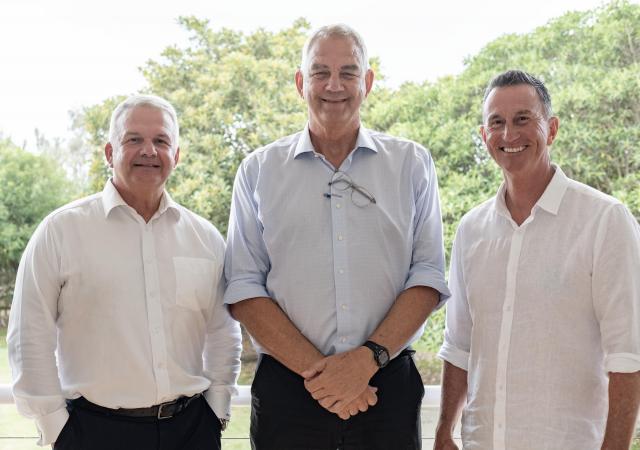
Two words, collaboration and cohesion, stood out last week during a discussion at the Peregian Beach surf club on the possibilities that may arise from the 2032 Brisbane Olympics.
Two Olympians, Duncan Armstrong and Larry Sengstock, and Sunshine Coast Airport chief executive officer Andrew Brodie joined Peregian Family and Friends president Leigh McCready to talk about the 2032 Olympics and what it may mean for Noosa and the Sunshine Coast.
Collaboration, cohesion, how we join together as one community, not a group of villages, and provide a consistent message is the key to success, said Olympic basketball player and now Noosa Council director of infrastructure services, Larry Senstock, who was Head of Sport during the 2006 Commonwealth Games.
“My job is to deliver programs and infrastructure for the Olympics,“ he said.
“I have a strong background in what sporting facilities are needed and how to encourage enthusiasm leading up to the Olympics.
“We don’t have many events but we will be heavily involved.“
Olympic gold medal swimmer Duncan Armstrong, who moved to the region only recently and sits on the board of Sunshine Coast 2032, the region’s vioce for the Olympics and Paralympics, likened the upcoming Olympics to the space race of the 1960s.
“Kennedy said we’re going to get a man on the moon. Every country united to contribute to the space race,“ he said.
“This has the potential to unite the community. We can all get on board and contribute.
“Events are coming to the Sunshine Coast and some from the Paralympics. This will have a profound effect on our youth. We can use this enthusiasm to expose our kids to the Olympics.“
In terms of business, the Olympics will put a spotlight on this region, Andrew Brodie said.
“We do need infrastructure. There’s been no five-star hotels built here in 30 years.“
Servicing an area from Bundaberg to Caboolture and a population of about one million people, the Sunshine Coast Airport would be an enabler in the lead up to the Olympic Games, advocating for better transport, not just in air travel but roads and rail, he said.
“We will spend close to $1 billion to upgrade the terminal,“ Mr Brodie said.
“We’ve been designated the third gateway into Australia for the Olympics.“
Mr Sengstock agreed that while Noosa had no events at the moment, people would want to come up to visit and go down for Olympics.
There’s an opportunity to get public transport right, he said.
“The Olympics offers so many opportunities. People want to be involved in sport and volunteering. “There’s opportunity for facilities for games or pre-game training camps,“ he said.
So far seven events have been named on the Sunshine Coast – soccer, basketball, marathon, marathon walking, cycling, mountain biking and kite boarding.
The Paralympics will be run two weeks later. No events in the region have been named so far for the Paralympics but the event provides an opportunity to focus on accessibility.
It’s important we meet all abilities needs, Mr Brodie said.
Mr Armstrong termed it universal access, the new buzz word which refers not just to meeting the access of people with a disability, but for everyone – older people, nursing mothers – and the region was a long way behind, he said.
“We don’t have facilities that people have lived with in other places for the past 10 years.
“It’s a massive opportunity,“ he said.
It may be 10 years away but the time is now to begin the conversations around the impact it will have on Noosa, the ways in which the community can take advantage of it, the legacy it will leave and the impact Noosa will have on the Olympic brand.
Mr Armstrong, who was heavily involved in the Sydney Olympics, talked about its reputation as the friendly games and the positive legacy left after it ended for both Sydney and the Olympic Games.
“In Sydney everything worked. How will our region affect the brand? How will we get people to come back and visit?“ he said.
Following their involvement in the Sydney 2000 Games volunteers still get together, wear their shirts and reminisce. That’s how much the Games meant to them, he said.
Looking to the future Mr Brodie said the airport’s aim after establishing the domestic market was to provide direct services to south-east Asia and the Pacific which would bring high value tourism and increased connectivity between the regions for passengers and freight as well as attracting international students.






